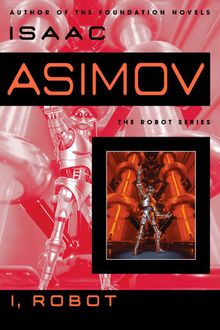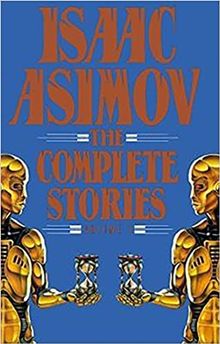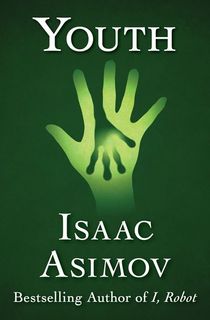Few authors can boast Asimov’s influence on the realm of science fiction.
Isaac Asimov's books are widely considered a cornerstone of the genre, and his stunning mix of philosophy, theology, and speculative fiction broadened the imaginations of generations of readers.
A true polymath, Asimov's curiosity led him to explore topics as widely varied as physics, literary criticism, and biblical exegesis. He was an extraordinarily prodigious writer and editor delving into the mystery genre, popular science, and, of course, sci-fi.
His works, in many ways, defined what we consider to be robotics and artificial intelligence. Think of any sci-fi author and you can be almost certain that Asimov is counted among their influences.
While you really can’t go wrong with any of Asimov’s varied works, the titles below are a few of his best — but they only begin to scratch the surface.

I, Robot
Arguably Isaac Asimov’s most well-known work, I,Robot is a towering achievement in science fiction storytelling.
Originally published in 1950, Asimov's predictions for the impact of artificial intelligence on the world have proven shockingly prescient.
These interwoven stories explore the ethical and moral implications of humanity’s push for ever more intelligent technology.
I, Robot has influenced and informed generations of not only writers, but scientists and researchers as well

Foundation
Foundation serves as the beginning of Asimov’s Foundation Series, which is arguably his finest work and a pillar of the science fiction genre.
Foundation begins in the waning days of the twelve thousand year rule of the benevolent Galactic Empire. A man named Hari Seldon has created a new science called Psychohistory that gives him visions of a bleak and brutal future.
To stave off this impending dark age, Seldon gathers the Empire’s greatest minds and flees to a barren planet to create a sanctuary for the rest of galaxy.
However, when the roiling turmoil of the failing empire finds its way to Seldon’s enclave, he must choose: submit to the savagery engulfing the galaxy, or stand and fight.
RELATED: What to Know About Asimov's Foundation Ahead of the Series

Foundation's Edge
The original Foundation trilogy concluded in 1953, but Asimov returned to the series decades later. Foundation's Edge was published in 1982 and became Asimov's first work to reach The New York Times bestsellers list. The story takes place 500 years after the establishment of the Foundation detailed in the first trilogy, but remnants of that conflict remain in the shadows.
Former Navy Officer Golan Trevize believes those remnants have become puppet masters, controlling events anonymously. The trouble comes in proving it to self-serving politicians and dealing with the danger that lies beneath the surface.

The Caves of Steel
The Caves of Steel is the first book in Isaac Asimov’s Robot Series, and takes place in a far-flung future where humanity lives in vast domed cities, eking out an existence on an over-populated and dying Earth.
It begins the central conflict of the Robot Series, between the the destitute and robot-weary Earthmen and their wealthy off-world counterparts, the Spacers.
When the novel opens, an earth-bound detective named Elijah Baley is assigned to investigate the death of a Spacer ambassador. Much to Baley’s dismay, he’s assigned a partner in the form of humanoid robot made in the likeness of the dead ambassador.
At its heart, The Caves of Steel is a hard-boiled detective story set against the backdrop of a bleak future-scape.
A clear line can be traced from The Caves of Steel to Philip K. Dick’s Do Android’ s Dream of Electric Sheep right on through to William Gibson’s Neuromancer and James S.A. Corey’s Leviathan Wakes.

Isaac Asimov: The Complete Stories
Asimov was an absurdly prolific writer and editor who penned some of his most thought provoking and best works in the form of short fiction. This collection is about as close to definitive as one can get.
It features some truly fascinating works like "Nightfall," "Satisfaction Guaranteed," and "The Dead Past." However, if you’re looking for quintessential Asimov, "The Last Question" is hard to top.
Spanning untold generations, "The Last Question" is told in six sequences, each with a human (or human descendant) asking the same question of a super computer: How can we stop of the end of the universe?

The Bicentennial Man
While The Bicentennial Man is only a novelette, shorter than many of the other entries on this list, it is in some respects one of Asimov's most notable works. The story won both the Hugo and Nebula awards for 1976 (after Ursula K. Le Guin refused the Nebula in political protest). It also became a Hollywood film starring Robin Williams, Sam Neill, and Embeth Davidtz. While the movie was generally considered a flop, it was nominated at the Academy Awards for Best Makeup.
The story follows robot Andrew and his inexorable draw toward the freedom of humanity. Over the course of, well, two centuries, readers follow Andrew's quest to feel what it means to be mortal in every sense of the word.

Isaac Asimov's Guide to Space and Earth
Isaac Asimov’s boundless intellectual curiosity made him one of the greatest minds of the twentieth century.
What made his speculative and science fiction so extraordinary – and what has kept it so prescient – is the deep understanding of the actual science that underpins it.
With Guide to Earth and Space, Asimov, who also wrote nonfiction, turns his pen to understanding the universe and the basics of modern astrophysics and theory. It’s brilliantly accessible, and a fascinating look at the science behind so much of the fiction.

The Gods Themselves
The Gods Themselves was an acknowledged favorite of Asimov himself. This heady piece of speculative fiction melds parallel universes, aliens, and humanity’s future into a stunning tale of mankind’s folly and possible redemption.
In the twenty-second century, humanity gains a limitless energy source from a parallel universe. However, it comes at a terrifying cost that few are aware of – the eventual destruction of the Earth and Sun.
A ragtag group of humans and aliens who know the truth fight to convince the world of impending doom.

Youth
This under-appreciated gem centers around two boys – Slim, the son of an astronomer, and Red, whose father is a wealthy industrialist.
When Slim accompanies his father to the sprawling estate of Red’s family, the two boys become friends. Red shows Slim some strange animals he found on the property, and the boys quickly bond with the creatures.
However, they soon discover that the seemingly friendly creatures may not be of this world, or as benign as they seem.

The Stars, Like Dust
In this prequel series to Foundation, Asimov explores an earlier period in the Galactic Empire.
With The Stars, Like Dust, Asimov introduces Biron Farrill, a student at the University of Earth and a native of the planet Tyrann.
Biron’s father was executed by the despotic regime that rules Tyrann, and now Biron himself is being targeted. His only chance for survival means joining rebellion forming on the planets surrounding Tyrann.
Soon, Biron is caught up in a treacherous conspiracy and forced to make a devastating choice.

I. Asimov: A Memoir
If you love Asimov's work, there's a good chance you'll love his memoir, too. The book showcases some of the contradictions and complexities of Asimov's life. For example, despite his passion of writing about galaxies and interplanetary travel, Asimov refused to fly on airplanes.
The memoir also touches on many of the other notable science fiction icons of the day, like Harlan Ellison and Arthur C. Clarke. Not only does Asimov explain how these other writers helped shape science fiction, but he draws back the curtain to tell you more about their personalities.
I. Asimov: A Memoir was published posthumously in 1994 and went on to win a Hugo Award. It is the final of three autobiographies Asimov published, joining In Memory Yet Green (1979) and In Joy Still Felt (1980).










